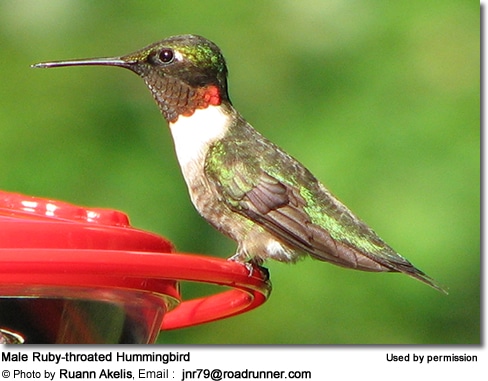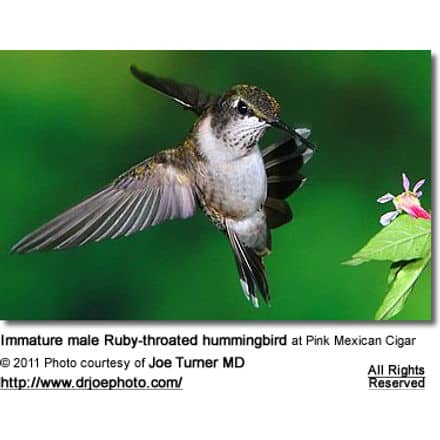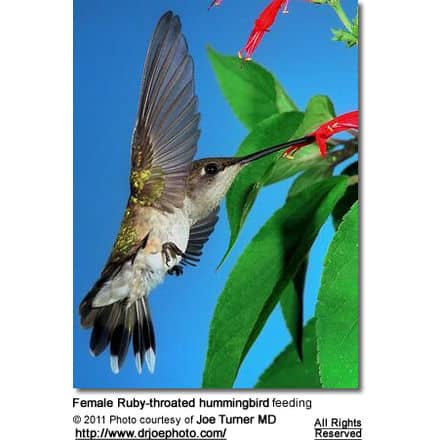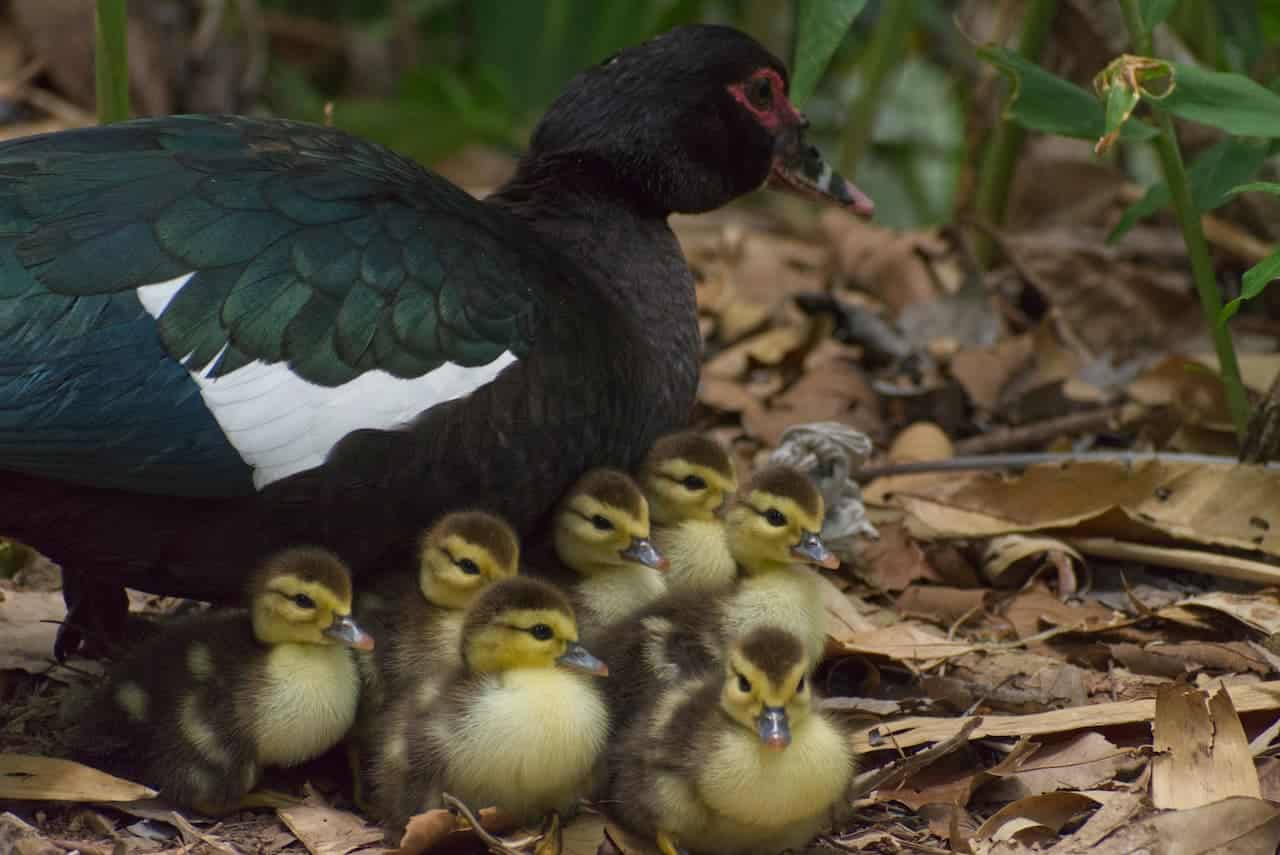Ruby-throated Hummingbird Migration
Ruby-throated Hummingbirds migrate north for breeding primarily to take advantage of the ample food resources and nesting opportunities in those areas.
At the same time, they want to avoid the fierce competition in the tropics during the summer months.
After the breeding season is over, they move down south to get away from the cold season and to avoid starvation, as their natural food sources (flowers and insects) are no longer readily available.


Ruby-throated Hummingbird Page
Migration Route / Timing
The migration route most of them take involves a nonstop flight over the Gulf of Mexico of approximately 500 miles (~800 km). Depending on weather conditions, this journey may take between 18 – 22 hours.
Considering that this hummingbird weighs as little as 3.40 to 3.80 g (0.12 to 0.13 oz) – or just about as much as a penny — this is an amazing accomplishment. In order to be able to meet the physical demands of this enormous task, the Ruby-throated Hummingbird nearly doubles its weight before its journey – from about 3.4 grams (0.12 oz) to over 6 grams (0.21 oz). However, once it reaches its destination, it will be starved and underweight, averaging only 2.5 grams (0.09 oz) – having lost more than half of its starting weight in a day.
There are some anecdotes that they may “hitchhike” on other (larger) birds. However, this is nothing more than whimsical folklore.
It is likely that many of them land and rest on offshore oil rigs or fishing boats; or they may make landfall anywhere between southern Texas and central Florida.
Some Ruby-throated Hummingbirds are said to do island-hopping across the Caribbean and enter the United States through the Florida Keys. Some are likely to avoid the Gulf of Mexico altogether and follow the coastal route. However, their migratory routes are poorly documented.
On land, their migration path follows the development of spring flowers.
Males migrate earlier than females, in both directions, primarily to establish their feeding territories before the arrival of the females.
Fall Migration:
The fall migration usually starts as early as July (mostly adult males) and is typically completed throughout North America by mid-November.
Most Ruby-throated Hummingbirds migrate south to central Mexico, some travel all the way down to west Panama.
Additionally, some winter in the Caribbean islands. Most recently, an increase in their wintering populations in southern Florida and along the Gulf Coast (southern Louisiana) in the USA have been noted.
A few records of them overwintering in North Carolina, Alabama and Georgia also exist.
This change in migration pattern is probably due to an increased availability of exotic flowering plants and hummingbird feeders in those areas that provide a suitable winter habitat for them.
Spring Migration
The spring migration to their northern summer location usually starts in January and most of them will arrive at their breeding location between the end of February to early April.
They breed in the extreme southern and western Canada, eastern half of the U.S. down to the Gulf of Mexico.
Ruby-throated Hummingbirds Migration Pattern in the United States (by state)
Arkansas — Ruby-throats arrive in early April, sometimes in mid- or late March. Leave in September or October.
Connecticut and Delaware — Leave by mid-September.
Florida — Ruby-throats arrive in early to mid-March. Leave in October.
Georgia — Ruby-throats arrive in March. Leave by mid-October.
Illinois and Indiana — Ruby-throats usually arrive in April. Leave in September.
Iowa — Ruby-throats usually arrive in late April or May. Leave in September.
Kansas and Kentucky— Ruby-throats usually arrive in April. Leave in September
Louisiana — Ruby-throats usually arrive in early or mid-March. Most leave in October, although some remain year-round.
Maine — Ruby-throats arrive in May. Leave in September.
Maryland — Ruby-throats arrive in April. Leave in September.
Massachusetts, Michigan and Minnesota — Ruby-throats arrive in May. Leave in September.
Mississippi –Ruby-throats arrive in March. Leave in October.
Missouri — Ruby-throats arrive in April. Leave in September.
Nebraska — Ruby-throats arrive in May. They only breed in the eastern part of the state. They leave in September.
New Hampshire — Ruby-throats arrive in May. Leave in September.
New Jersey — Ruby-throats usually arrive in April. Leave in late September.
New York –Ruby-throats arrive in mid- to late-April. Leave in late September.
North Carolina –Ruby-throats arrive in early April. Leave in September or October.
North Dakota — Ruby-throats arrive in early June. Leave my mid- or late August..
Ohio — Ruby-throats arrive in late April or early May. Leave in September.
Pennsylvania — Ruby-throats arrive in April. Lave in late September or October.
Rhode Island — Ruby-throats arrive in April. Leave in September.
South Carolina –Ruby-throats arrive in late March or early April ; they and leave in September or October.
South Dakota — Ruby-throats arrive in May. Leave in September.
Tennessee— Ruby-throats arrive in April. Leave in early October.
Texas — In East Texas, Ruby-throats arrive in March and leave in October. In west Texas they arrive in March and leave in September. Breeds in the eastern half of Texas.
Vermont and Virginia — Ruby-throats arrive in April. Leave in September.
West Virginia — Ruby-throats arrive in April. Leave in September or possibly October.
Wisconsin — Ruby-throats arrive in April or May. Leave in September.
More Information about Ruby-throated Hummingbirds

Beauty Of Birds strives to maintain accurate and up-to-date information; however, mistakes do happen. If you would like to correct or update any of the information, please contact us. THANK YOU!!!







